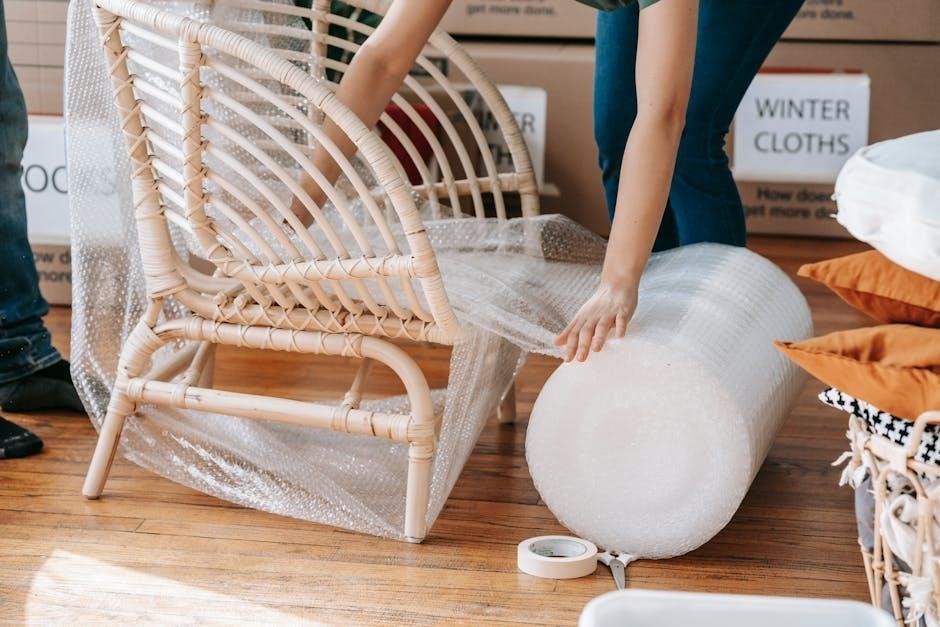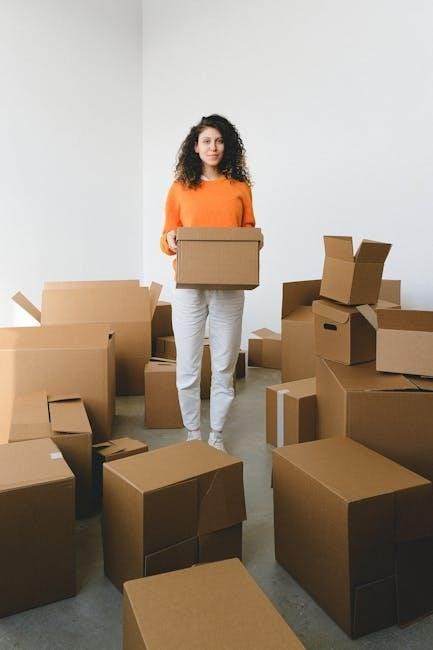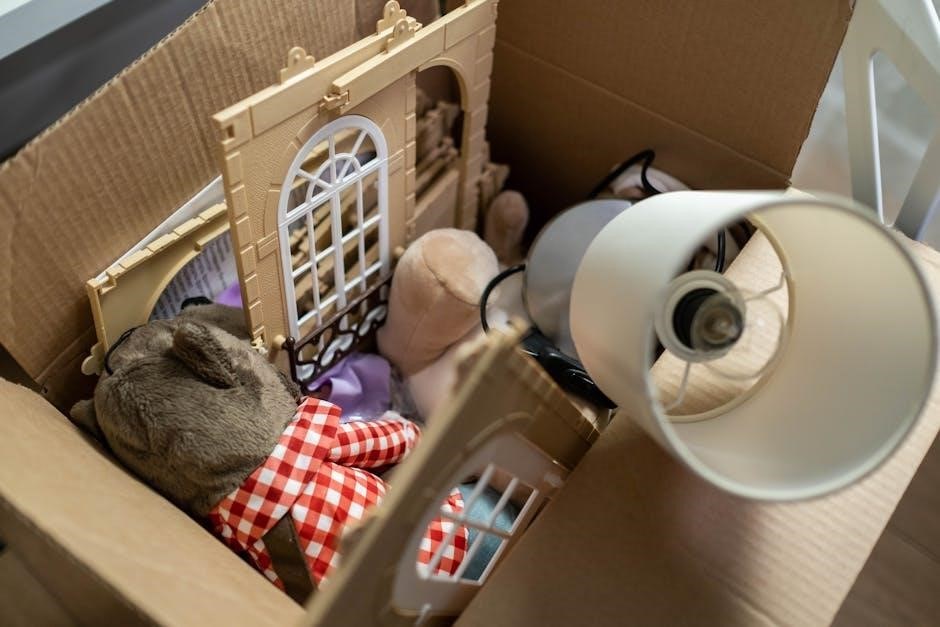A room-by-room checklist is essential for a stress-free move, ensuring every item is accounted for and organized. It helps you track progress, avoid last-minute chaos, and make unpacking easier.
Why a Room-by-Room Checklist is Essential for Moving
A room-by-room checklist ensures organization and reduces stress during relocation. It helps track progress, prevents items from being lost, and makes unpacking systematic. By breaking tasks into manageable sections, you can avoid last-minute chaos and ensure everything is accounted for. This approach also allows for better time management and efficient packing, making the entire moving process smoother and less overwhelming.
What to Include in Your Moving Checklist
Your moving checklist should include a detailed inventory of items room-by-room, packing supplies needed, and a timeline for tasks. List essentials like dishes, pots, clothing, and electronics, and note fragile or special-care items. Add tips for labeling boxes and organizing by room. Include contact information for utilities and services, and deadlines for address changes. Don’t forget a section for last-minute tasks, ensuring everything is covered for a smooth transition.

Kitchen
The kitchen section should include dishes, glassware, pots, pans, cutlery, and cookbooks. List reusable outdoor dishes and ensure all items are clean and securely packed.
Dishes and Glassware
Start by listing all dishes, cups, bowls, and glassware. Check for any damaged or broken items and decide whether to repair or discard them. Pack fragile items like glassware separately, using bubble wrap for protection. Place plates and bowls in sturdy boxes, ensuring they are tightly secured. Label each box clearly as “Fragile” and indicate the room it belongs to. This helps movers handle them carefully and ensures everything reaches its destination safely.
Pots, Pans, and Cutlery
Organize pots, pans, and cutlery by size and type. Wrap fragile or delicate items in bubble wrap to prevent damage. Place heavier items like pots and pans at the bottom of boxes for stability. Store cutlery in smaller, separate containers to avoid tangling. Label each box with its contents and the room it belongs to. Ensure all items are clean and dry before packing to prevent moisture damage during transit. This helps maintain organization and safety during the move.
Cookbooks and Kitchen Gadgets
Pack cookbooks by size and secure them in sturdy boxes to prevent bending. For kitchen gadgets, ensure all cables and accessories are included. Wrap fragile items like blenders or toasters in bubble wrap. Label boxes clearly, noting contents and the room they belong to. Keep frequently used gadgets easily accessible for unpacking. Consider creating a list of gadgets for quick reference after the move. This ensures everything is accounted for and protected during transit.
Bedroom
Organize clothing, shoes, and accessories, sorting items to keep, donate, or discard. Pack bedding, linens, and curtains, labeling boxes by category for easy unpacking. Secure furniture and decor, ensuring fragile items are well-protected. Use this checklist to track progress and ensure a smooth transition to your new space.
Clothing and Accessories
Start by sorting clothing into categories: keep, donate, or discard. Use sturdy boxes for folded items and wardrobe boxes for hanging clothes. Pack shoes separately, using tissue paper for protection. Accessories like belts, hats, and jewelry should be organized in small, labeled containers. Consider seasonal items and store them appropriately. Label each box with its contents and the room it belongs to. This ensures efficient unpacking and helps you locate essentials quickly after the move.
Bedding and Linens
Organize bedding by type: sheets, blankets, comforters, and pillowcases. Use vacuum-sealed bags to save space and protect items from dust. Label each bag with its contents and the room it belongs to. Include towels, washcloths, and table linens in separate, clearly marked boxes. Consider color-coding boxes by room for easy identification. This ensures linens are unpacked efficiently and ready for use in your new home. Proper packing prevents wrinkles and damage during transit.
Furniture and Decor
List all furniture pieces, noting their condition and disassembly needs. Disassemble large items like beds or tables, and store hardware in labeled bags. Protect mirrors, artwork, and fragile decor with bubble wrap or padding. Use sturdy boxes for smaller decorative items. Label boxes with room names and contents for easy placement. Keep tools for reassembly handy and separate. This ensures furniture and decor arrive safely and are ready for setup in your new space.
Living Room
Organize electronics, media, furniture, and decor; Pack cables securely, label boxes with contents, and protect fragile items like lamps and decorations for a smooth move.
Electronics and Media
Start by gathering and labeling all cables and chords. Secure electronic devices like TVs, gaming consoles, and sound systems in protective covers or original packaging. Pack media items such as CDs, DVDs, and video games in sturdy boxes, ensuring they are cushioned to prevent damage. Consider creating an inventory list for easy tracking. Remember to update your address with streaming services and utility providers before the move. Keep essential electronics easily accessible for setup in your new home.
Furniture and Lighting
Disassemble large furniture pieces like beds and tables, and label all hardware in sealed bags. Wrap chairs, sofas, and mattresses in protective covers. For lighting, carefully pack lamps, fixtures, and bulbs in bubble wrap. Use sturdy boxes for fragile items and label them as “Fragile.” Keep track of which furniture belongs in each room to simplify reassembly. Ensure all items are clean and dry before packing to prevent damage during transit.
Decor and Accessories
Pack decorative items like vases, paintings, and mirrors in bubble wrap or specialized boxes to prevent breakage. Use soft materials to protect fragile accessories. Label boxes with “Fragile” and indicate the room they belong in. Store small items, such as picture hooks and hanging hardware, in separate containers. Keep an inventory of all decor to ensure nothing is misplaced during the move. Handle each item with care to maintain their condition and appearance.
Bathroom
Start with toiletries, personal care items, and towels. Use protective covers for liquids and fragile items. Pack cleaning supplies separately. Keep an inventory of all bathroom essentials. Ensure everything is organized and easy to locate in your new space. This approach helps maintain order and reduces stress during the move.
Toiletries and Personal Care Items
Pack toiletries and personal care items separately, including toothbrushes, toothpaste, shampoo, conditioner, and skincare products. Use travel-sized containers for essentials and keep them easily accessible. Include razors, shaving cream, and makeup in labeled bags. Don’t forget feminine hygiene products and personal hygiene items like wet wipes. Secure fragile items like perfume or glass bottles with protective wrapping. Keep a list of all toiletries to ensure nothing is missed during the move. This helps maintain organization and simplifies unpacking in your new space.
Towels and Shower Supplies
Organize towels by type (bath, hand, washcloths) and pack them in labeled boxes. Include shower curtains, rings, and bath mats. Roll towels to save space and prevent wrinkles. Use vacuum-sealed bags for out-of-season items to reduce bulk. Pack a small set of towels separately for immediate use on moving day. Label boxes clearly to ensure they go directly to the bathroom. This makes unpacking easier and ensures essentials are accessible right away.
Cleaning Supplies
Gather all cleaning essentials like all-purpose cleaners, glass cleaners, and disinfectants. Include sponges, scrubbers, mops, buckets, and vacuum accessories. Organize items by type or brand to prevent leakage during transit. Pack heavy-duty cleaning tools separately and label them clearly. Designate a box for disposable gloves and trash bags. Ensure fragile items like spray bottles are securely wrapped. Keep a small vacuum or dustpan handy for quick cleanups on moving day. This ensures your new space is ready for a fresh start.

Home Office
Pack office supplies, electronics, and cables neatly. Organize books by category and label boxes clearly. Keep essential items like chargers and stationery easily accessible during the move.
Office Supplies and Stationery
Organize office supplies like pens, notebooks, and files into labeled boxes. Include stationery, envelopes, and sticky notes. Pack desk organizers separately to keep small items tidy. Use sturdy boxes for heavy items like binders or staplers. Label boxes clearly as “Office Supplies” and indicate the room. Keep frequently used items, such as chargers or essential documents, in an easily accessible bag. Ensure all stationery is neatly packed to avoid damage during transit.
Electronics and Cables
When packing electronics, ensure each device is wrapped securely to prevent damage. Use anti-static packaging for sensitive components. Label cables clearly and organize them in ziplock bags or cable organizers. Keep essential chargers and adapters in an easily accessible bag. Pack manuals and warranties together for reference. Securely tape loose cables to devices or bundle them neatly. Make sure all electronics are accounted for in your moving checklist to avoid losing any items during the move.
Books and Documents
Organize books by genre or size and pack them in sturdy boxes with protective padding. Separate important documents like invoices, receipts, and contracts into labeled folders. Use acid-free boxes for sensitive papers to prevent damage. Keep essential documents, such as passports and identification, in an easily accessible bag. Ensure all books and documents are inventoried and accounted for in your moving checklist to avoid losing or damaging them during the move.
Storage Areas
Storage areas like attics and basements often contain bulky items such as seasonal decorations, tools, and equipment. Use sturdy boxes, label contents clearly, and check expiration dates for stored chemicals or batteries to ensure safety during the move.
Attic and Basement Items
Attics and basements often contain bulky items like seasonal decorations, tools, and equipment; Use sturdy boxes for fragile items, label contents clearly, and check expiration dates for stored chemicals or batteries. Consider donating or recycling items no longer needed. Pack heavy items first to prevent damage. Ensure items are clean and dry before packing to avoid mold or mildew. Keep an inventory of stored items for easy tracking during the move.
Garage and Outdoor Equipment
Garages and outdoor spaces often hold bulky items like tools, sports gear, and gardening equipment. Categorize items by type and pack them in sturdy boxes. Label each box with its contents and the room it belongs to. Clean and dry equipment before packing to prevent damage. Dispose of hazardous materials like paint or fuel responsibly. Keep an inventory of items and pack essentials separately for easy access on moving day. This ensures everything arrives safely and is easy to locate.

Packing Tips
Start packing early to avoid last-minute stress. Use sturdy boxes and packing materials to protect fragile items. Label boxes clearly with contents and destination rooms. Pack room by room to maintain organization. Fill boxes completely to prevent shifting during transit. Keep essential items, like toiletries and a change of clothes, easily accessible. Double-check all boxes before sealing them. This systematic approach ensures a smooth and efficient move, reducing chaos and saving time.
General Packing Tips
Start by gathering sturdy boxes, packing paper, and tape. Pack heavy items at the bottom of boxes and lighter ones on top. Avoid overfilling boxes to prevent breaking. Label each box with its contents and the room it belongs in. Use clear markers to indicate fragile items. Pack essentials like toiletries and a change of clothes separately for easy access. Keep valuable items with you during the move. Double-check all boxes before sealing to ensure everything is included. This organized approach ensures a smooth transition to your new home.
Labeling and Organizing Boxes
Clearly label each box with its contents and the room it belongs in using a bold marker. Number boxes and keep a master list to track them. Use color-coded labels for different rooms to simplify unpacking. Mark fragile boxes distinctly and ensure they are placed upright. Avoid labeling boxes as “Miscellaneous,” as it can lead to confusion. Organize boxes by size and weight for efficient loading. This system ensures everything is accounted for and placed correctly in your new home, making unpacking much easier and stress-free.
A room-by-room moving checklist ensures organization and reduces stress, making your move manageable. It provides a clear guide to track progress and guarantees a smooth transition to your new home.
Final Checklist Review
Conducting a final review of your room-by-room checklist ensures no items are overlooked. This step confirms all tasks are completed, boxes are labeled, and essentials are packed separately. It allows you to verify that every room’s contents are accounted for, reducing the risk of lost or misplaced items during the move. A thorough review guarantees a seamless transition and provides peace of mind as you prepare for your new home. Proper organization is key to a successful relocation.
Downloading Your Moving Checklist PDF
Downloading a moving checklist PDF provides a comprehensive, organized guide to streamline your moving process. This invaluable tool offers a detailed, room-by-room breakdown, ensuring no item is forgotten. It includes packing tips, labeling advice, and a timeline to stay on track. By downloading the PDF, you’ll have a clear roadmap for a stress-free relocation. This checklist is customizable, allowing you to tailor it to your specific needs and preferences, making it an indispensable resource for a smooth move.
